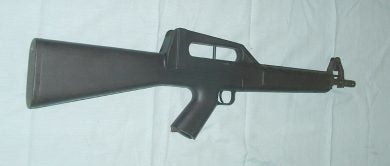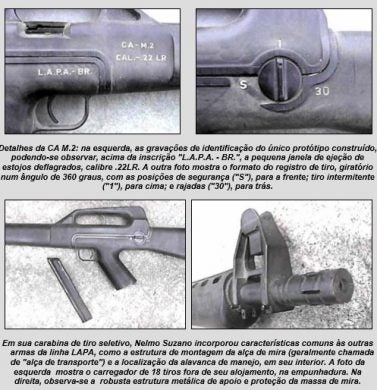In the early-1980s, while acting as an associate and head designer of the Rio de Janeiro-based LAPA – Laboratório de Projetos de Armamento Automático Ltda company, Nelmo Suzano also found the time to create two .22LR carbines, which shared several design features with his 9x19mm SM Modelo 3 submachine gun and 5.56x45mm FA Modelo 3 bullpup rifle. To begin with, they employed polymer-based bodies topped by a so-called carry handle, actually, the rear sight protection structure.

The semi-auto CE MOD.01 was successfully tested and approved in Brazilian Army examination for “permitted-use” (non-military) guns in 1982.
The semi-auto model was called the CE (Carabina Esportiva, Sports Carbine) Modelo 01, being a blowback-operated gun fed by a 10-round magazine inserted in the pistol grip. It was fitted with a 370mm barrel, which gave the weapon an overall length of 755mm. Empty weight was only 2.1kg. The flip-type aperture rear sight had settings for 50 and 100 meters, and was fully protected by the carry handle structure, while the cocking piece, a simple vertical rod in the prototype, ran inside that. To cope with the straight-line configuration, the front sight post was mounted on top of an elevated metal structure and protected by side ears. Fire-selection (“S” and “1”) was made by a disc-shaped unit on the left side of the gun.
The single prototype built was submitted to basic functioning and safety tests at the Brazilian Army Marambaia Proving Grounds in September, 1982, receiving the grade of “good quality weapon”. No series manufacture was undertaken.

The CA MOD.02 prototype was distinguishable from the semi-auto model by the larger capacity magazine in the pistol grip and the curved shape of the cocking lever within the carry handle.
Side-by-side with the sports model, Nelmo also completed a selective-fire variant, the CA (Carabina Automática, Automatic Carbine) Modelo 02. With the same dimensions and weight of the semi-auto model, the prototype with rock-and-roll capability was distinguishable for having a slightly-curved cocking lever and a longer 18-round magazine in the pistol grip. Depending on the ammo brand used, the CA reached incredible cyclic rates of fire ranging from 1,200 to over 2,000 rounds per minute. The weapon fired from the closed-bolt position, whose hammer and firing pin were based on those used in the LAPA bullpup rifle. It also remained in the prototype stage, only, and was never officially submitted to tests.

Closer view of the selective-fire CA MOD.02 shows the disc-shaped fire selector with the markings “S” (front), “1” (top), and “30” (rear) displayed in a 180 degrees arc.

The magazine catch was located at the rear bottom of the pistol grip, being pressed forward to actuate.

Some family traces are evident in this side-by-side view of Nelmo Suzano’s CA MOD.02 selective-fire carbine and the SM MOD.3 submachine gun.

Part of author’s “Enciclopédia de Submetralhadoras” e-book with pics of the CA automatic carbine. Note the use of a flash hider, not really necessary in a .22LR gun, but very neat-looking. Sharpen your Portuguese language, folks!
As a final note, one may now wonder why the heck would anyone want a voracious rimfire spitter. It just so happened that at that time (i.e. 1970s) there were some proponents that such .22LR buzzguns could well find a place in LE/riot control/prison security duties. In fact, this is what the American-180 submachine gun of that period was about. Adapted to more modern production methods, it re-appeared in the former Yugoslavia as the MGV-176 during the 1980s.
 Your Privacy Choices
Your Privacy Choices
